Day 01 Arrive Paro – Thimphu
After arriving & visa formalities and collection of baggage, you will be welcomed by our tour representative who will be your tour guide during your entire trip in Bhutan.
Check into your hotel in Thimphu.
After lunch, you can choose to visit any or all of the following places:-
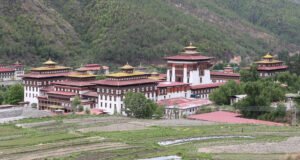
Tashichho Dzong, a Buddhist monastery cum fortress at the northern edge of Thimpu the capital city of Bhutan. The original Thimphu Dzong (the Dho-Ngyen Dzong) is said to have been constructed in 1216 by Lama Gyalwa Lhanangpa.
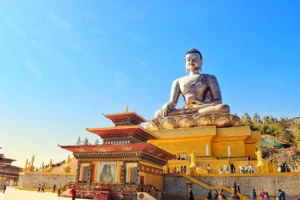
Kuensel Phodrang
The Kuensel Phodrang or the Buddha point is the world’s largest sitting Buddha statue, the statue is 167 feet high.
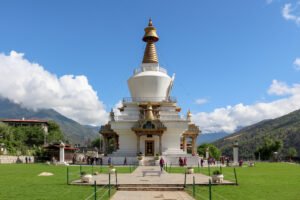
The National Memorial was built by Bhutan’s third king, H.M. Jigme Dorji Wangchuck who is also known as the “father of modern Bhutan.”
The national Memorial Chorten is located in the center of the capital city, Thimphu and is designed like a Tibetan style Chorten.
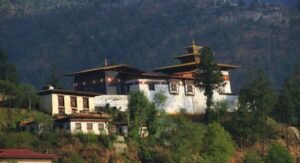
Changangkha lhakhang.
The Chagangkha Lhakahng temple is a early medieval Buddhist temple in the capital city Thimphu. The temple is situated on a ridge overlooking the city, near Mohitang on the outskirts of Thimphu. The temple is the oldest temple in Thimphu and was constructed by Lama Phajo Drukgom Zhigpo in the 12 century AD. Lama Phajo Drukgom Zhigpo is also the founder of the Drukpa Kaygo School of Buddhism. The Lhakhang’s central deity is Chenirizig. There is a large statue of
Chenrizig, the 11 headed, thousand arm manifestation of Avolokiteshwara. The prayer books in the temple are larger in size compared to the usual Buddhist texts. There are also large prayer wheels and paintings in the walls of the temple.
The temple offers an excellent view of the city of Thimphu from its courtyard.
Over Night in Thimphu Hotel.
Day 02: Thimphu.
After early morning breakfast, a choice to visit:-
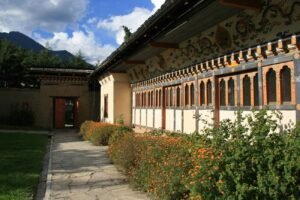
Folk Heritage Museum
The folk heritage museum was open to the general public in 2001 upon completion. It treasures troves of culture and rich Bhutanese heritage provide rich insights into the Bhutanese ethos.
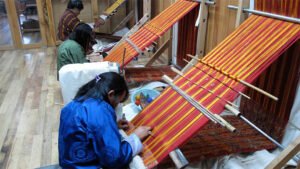
National Textile Museum
The second important Museum that also opened its doors in 2001 is the National Textile Museum of Bhutan. During a trip to this museum you will get an up close and personal experience of the living national art of weaving.
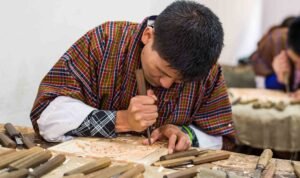
National Institute of Zorig Chusum.
The art and crafts currently taught in Bhutan, were introduced to the country in the 15th century by Trenton Pema Lingpa.
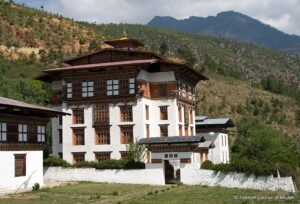
Bhutan’s National Library was established in the 1967. Its mission is to preserve the literary treasures of the nation which constitute a significant element of Bhutan’s rich and vibrant cultural heritage.
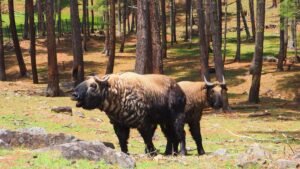
Motithang Takin Preserve
The Motithang Takin Preserve also known as the Thimphu Zoo by many is a small natural preserve for the Takin Bhutan’s national animal.
The Jungshi Handmade Paper Factory is a small paper factory located in Thimphu that produces paper using traditional Bhutanese methods. The paper products produced at the factory are made from Daphne or Mulberry plant bark.
Overnight in a hotel in Thimphu.
Day 03: Thimphu – Punakha.
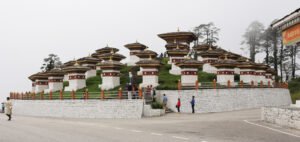
Post early breakfast, you will drive towards Punakha via Dochula Pass. We will stop over for tea at Dochula (3,100 m), you can get stunning
views of the Himalayan ranges.
NOTE: Lam peri National Park.
You can visit the following places in Punakha.

Punakha Dzong.
The Punakha Dzong or the Pungtang Dechen Phortang Dzong is located at the confluence of the Mo Chhu and the Po Chhu River, combine to form the Puna Tsang Chu which in turn is a tributary of the mighty Brahmaputra River. The Dzhong was constructed by Zhabdrung Ngawang Namgyal Wangchuck in 1638.
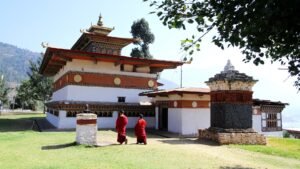
Chimmi Lhakhang
After early morning breakfast, you will drive to Paro and on the way, Admire the view en route the valley of Wangdiphodrang. We will drive to Chimmi Lhakhang to start with. The monastery stands on a small hill close to the village of Lobesa and was constructed in 1499 by Ngawang Choegyel, the 14thDrukpaheirarch.
Over Night in Punakha Hotel.
Day 04. Punakha – Wangdue – Trongsa via Bumthang
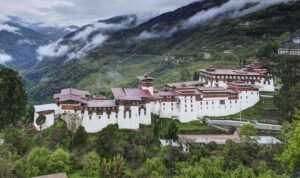
Trongsa Dzong.
The way to Bumthang you can view one of the Trongsa Dzong is the largest dzong fortress in Bhutan, located in Trongsa (formerly Tongsa) in Trongsa district, in the centre of the country. Built on a spur overlooking the gorge of the Mangde River, a temple was first established at the location in 1543 by the Drukpalama, Ngagi Wangchuk son of Ngawang Chhojey. In 1647, his great- grandson Shabdrung Ngawang Namgyal (Shabdrung or Zhabdrung being
his title), constructed the first dzong to replace it, called Chökhor Rabtentse Dzong with a shorter version of Choetse Dzong. It was enlarged several times during the 18th century; the Chenrezig Lhakang
was built in 1715 and a whole complex, including the Maitreya (Jampa) temple, was added in 1771. The dzong has since been repaired on several occasions; it was damaged during the 1897 Assam
Lunch will be taken care on the way.
Check in Trongsa Hotel.
Day 05- Trongsa – Bumthang.
Early Breakfast drive to Bumtahang.After Lunch you can visit following places in Bumthang. earthquake and underwent extensive renovation in 1927 and 1999.
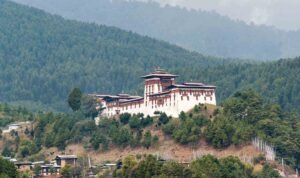
Jakar Dzong.
Jakar Dzong or Jakar Yugyal Dzong is the dzong of the Bumthang District in central Bhutan. It is located on a ridge above Jakartown in the Chamkhar valley of Bumthang. It is built on the site of an earlier temple established by the Ralung hierarch Yongzin Ngagi Wangchuk (1517– 1554) when he came to Bhutan. Jakar Dzong may be the largest dzong in Bhutan, with a circumference of more than 1,500
metres (4,900 ft).
The name Jakar is derived from the word bjakhab, meaning “white bird”, in reference to Jakar’s foundation myth, according to which a roosting white bird signaled the proper and auspicious location to found a monastery around 1549.
Over Night in Bumthang Hotel.
Day:06 Bumthang – Bumthang.
After breakfast you can have following places to visit and the lunch will be taken systematically.
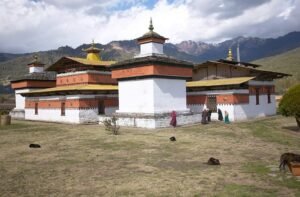
Jambay Lhakhang.
It was divined that the supine demoness was causing obstruction to the spread of Buddhism, and temples were constructed on her body parts that spread across Tibet, Bhutan and the borderlands. The best known of these temples are Jokhang in Lhasa, Kichu in Paro, Bhutan and Jambay Lhakhang in Bumthang District, Bhutan.
Other, lesser-known temples in Bhutan have been destroyed, but it is believed that, among others, Kongchogsum in Bumthang, Khainein Lhuntse and two temples in Haa District may have part of these 108 temples. Jambay Lhakhang was visited by Padmasambhava and restored by King Sindhu Raja after the former returned his life force. It has been repaired and rebuilt several times over time.
The first of the three temples, the Guru Lhakhang, is the oldest and was built in 1652 by Mingyur Tenpa when he was penlop of Trongsa. Tucked just below the eaves is a figure of a snow lion with a jachung (also called garuda) above it, which represents the famous struggle between Guru Rinpoche (appearing as the garuda) and the local demon, Shelging Kharpo (as the snow lion). The statue of Shelging Kharpo inside is usually hidden from view.
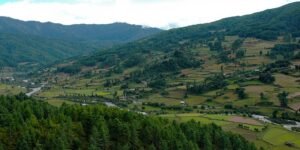

Legend has it a sacred treasure hidden by an ancient guru was revealed with a burning butter lamp from these waters. Though it’s known as Mebar Tsho, or “the Burning Lake,” this sacred site is not quite a lake at all, but rather a pool along a river in the Tang Valley. Local legend says that the water contained a hidden holy treasure uncovered through divination by one of Bhutan’s most important religious figures, Terton Pema Lingpa, in the late 1400s.

Thangbi Lakhang
Located beyond Kuje Lhakhang, it is an easy 2 hr walk through the beautiful upper Chhoekhor Valley from where the motorable road ends. It was founded in 1470 by the 4th Shamar Rinpoche (the red hat Karmapa), Chokki Drakpa an important lama of the Karma Kagyudpa sect.
Pemalingpa later took over and it became Nyingmapa. The iron curtain at the entrance is said to have been cast by the saint himself.
Towards the north of the Thangbi Monastery lie two clustered villages of Goling (2740 m) and Kharsath (2750m) within the radius of 2 km. Further north on a higher elevation Shukdrak Monastery (2950m) founded by Guru Padma Sambhava is perched on a mysterious cliff overlooking the beautiful Thangbi valley. A very pleasant one-hour walk from road head takes one to the sacred place.
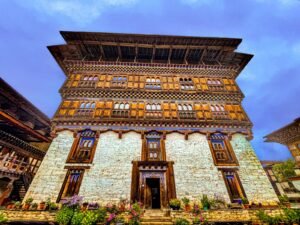
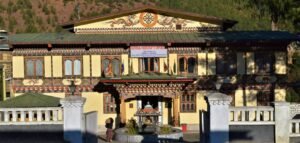
Overnight in a hotel in Bumthang
Day 07: Bumthang – Wangdue,Punakha.
After breakfast you will drive to Wangdue(Punakha)..
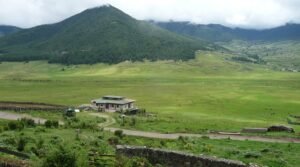
Each winter the people of Bhutan’s Phobjikha Valley await the return of Black- necked Cranes. The stately four-foot-tall birds migrate from their breeding grounds in the upper Tibetan Plateau to this remote timber-lined bowl surrounded by massive Himalayan peaks, and roost there until spring amid the alpine wetlands. To the Buddhists of this tiny kingdom, the birds are heavenly emissaries, avatars of long-gone ancestors and lost loved ones, signifying longevity, peace, and prosperity. The graceful birds are so culturally important that they’re painted on the sides of homes and businesses throughout the country. In Phobjikha, farmers believe the birds’ presence ensures healthy crops, and tourists travel to the remote valley from around the world to see the cranes. Phobjikha is one of the last strongholds of
the threatened Black-necked Crane, a close cousin to the endangered Whooping Crane of North America. The species, only discovered in 1876 due to its remote alpine range in China, Tibet, Bhutan, and India, is vulnerable. Across South Asia, there are as few as 5,000 of the birds in the wild. Grazing, agriculture, and hydroelectricity have all taken a toll on the high-altitude wetlands that the birds depend on, and climate change may further alter their habitat.

Overnight in a hotel in Wangdue, Punakha.
Day 08: Wangdue(Punakha) – Paro.
After early morning breakfast, you will drive to Paro and on the way, we will visit :-
Simtokha Dzong
Ta Dzong (National Museum of Bhutan)
Rimpung Dzong.
Overnight in a hotel in Paro
Day 09: Paro

After early morning breakfast, we will take you for a morning hike up to Taktsang Monastery, also known as ‘Tiger’s Nest’. Hanging precariously and magically from a rather steep cliff, the Taktshang monastery is a monument of genuine pride for the Bhutanese nation. It defies architectural principles to the core and amazes tourists from around the world. It is a sight to behold.
Kyichu Lhakhang
The Jowo Temple of Kyichu is one of the oldest temples in Bhutan. The temple was built by the Tibetan King Songtsen Gampo in the 7th Century AD. The Kyichu Lhakhang was one of the 108 temples constructed by him to subdue a demon that was terrorizing the people of the Himalayas. The temple is believed to have been visited by the Guru Rinpoche in the 8th Century during his visit to the Paro Valley. Other important personalities to have visited the temple in antiquity include Lam Kha Nga and the Phajo Dugom Zhigpo. The Lhakahng underwent many extensions during the ages with the last one being carried out in 1965 by the Queen Mother Ashi Kezang Choden Wangchuck. She added another new structure to the temple
called the Guru Lhakahng. As one of the oldest Lhakhangs, it houses many important relics. One of the most important relics of the temple is a 7th century statue of Jowo Sakyamuni which is believed to have casted at the same time as it famous counterpart in Lhasa Tibet.
Over Night in Paro Hotel.
Day 10: Paro – Paro.
After Breakfast visit following places in Paro:
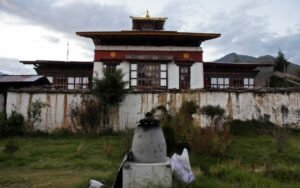
Druk choeding
Druk Choeding is also known as Tshongdoe Naktshang. The temple was built by Ngawang Chhogyel, who was a prince of Ralung and the ancestor of Zhabdrung Ngawang Namgyal, in 1525. In the temple,
visitors will find a statue of the Future Buddha known as Jampa in the seated position.
There is also an image of the deity known as Gyenyen who is the protector of Bhutan. Gyenyen is surrounded by a collection of ancient swords, shields and other weaponry.

Dumtse Lhakang
The Dumtse lhakhang Temple is located just north of the city of Paro. The Dumtse Lhabhang temple is very unique in its design as it’s designed like a Chorten (Stupa), which is highly unlike any guide
other Lhakhang / temple in Bhutan. The Temple was built in the 1443 AD by Thantong Gyalpo, known as the iron bridge builder in Bhutanese legend.

National Handicrafts Emporium
The National Handcrafts Emporium is a state run Handicrafts showroom in 4 different cities of Bhutan. The emporium is run by the National Woman’s Association of Bhutan as a Non-Government Organization that is run under the royal supervision of Her Royal Highness Ashi Sonam Choden Wangchuk. The Handicrafts Emporium is a showcase the finest handicrafts of the country and supports one of Bhutan’s most important income generating activities. The lack of an organized handicrafts industry in Bhutan is one of the biggest concerns of the organization running the Emporium as they strive to create some form of organization in this otherwise unorganized sector. Apart from its central branch in Thimphu the emporium has now opened its doors in 3 more locations including one at the Paro International Airport, Bumthang and the Rural Handicrafts Sales Centre at Tashigang.
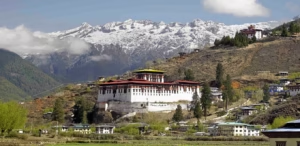
Rimpung Dzong
The Paro Dzong is probably Bhutan’s best known and most iconic Dzong. This is probably the first building you will notice when you land at Paro International Airport and will probably be your first memory of
Bhutan. The imposing Dzong is perhaps the finest example of Dzong architecture existing the world today, the massive buttered walls of the fortress dominates over the valley. The Rinpung Dzong’s names translate to the “Fortress on a heap of Jewels “.
The fortress was constructed in 1644 by Zhabdrung Ngawang Namgyal on the foundations of an ancient monastery. The approach toward the Dzong is through a traditional covered bridge called the Nemi Zam. A paved stone path runs alongside the imposing outer walls of the structure. The valley’s annual springtime religious
festival called the Paro Tsechu is organized each year in the courtyard of the dzong and is attended by tourists from all over the
world.

Ta Dzong (National Museum of Bhutan)
The National Museum of Bhutan is housed inside the six storied circular Ta Dzong. The Ta Dzong is a medieval watch tower situated above the Rimpung Dzong. The Ta Dzong was constructed in 1656 with a purpose to give advance warning to the Paro Dzong in case of an approaching army, in fact the word Ta means ‘to see’ in Dzongkha.
The future first king was imprisoned here for a brief period in 1872. In 1968 the Ta Dzong was converted into the National Museum of Bhutan. The Museum houses a priceless collection of textile, costumes, paintings, appliqué, wooden handicrafts, weapons, amour and jewelry. There is a small section dedicated to the natural history of Bhutan. There is a small chapel on the top of the building with icons
representing Himalayan Buddhist traditions.
There are 2 orange trees located in the courtyard of the temple; there is a belief amongst the locals that these orange trees bear fruit all year long. This site is one of the most sacred holy sites is all of Bhutan, and our companies travel consultants recommend every traveller to visit this sacred temple.
Overnight in a hotel in Paro.
Day: 11 Departure.
In the morning after early breakfast we will see you off at the Paro Airport for your onward destinations.
